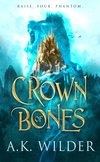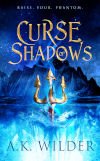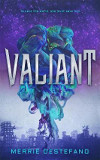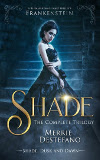.
Introduction
One of the very special aspects of the Supernatural Underground
is being part of a community of writers, and Amanda Arista is one of the authors
who has been a friend and fellow community member here from close to the
get-go.
Amanda’s brand of fiction is paranormal urban
fantasy, and although I’m more of an epic kinda gal in writing terms, when it
comes to reading I love a paranormal tale. As both a fellow writer and a
reader, I’ve always loved the “voice” of Amanda’s heroines, Violet and Merci,
and her ability to spin an intriguing mystery with plenty of gritty noir, as
well as paranormal elements.
So I’m delighted to be talking with Amanda today about the magic in her Diaries Of An Urban Panther and Merci
Lanard Files paranormal urban fantasy series.
Welcoming Amanda Arista: In Conversation On Magic In Her Diaries Of An Urban Panther & Merci Lanard Files Series
Helen: Urban
fantasy is all about the intersection of the paranormal and our everyday world.
What do you believe is most important, and find most challenging, about writing
magic in that context
Amanda:
Hello there!!! I think the fun part of
writing paranormal/urban fantasy versus a high fantasy is that there isn’t much
to actually build – it’s just finding the magic in everyday things and telling
a story behind it. For me, writing urban fantasy is just writing the real world
with a magical icing over it. The language is the same, the air make up is the
same, the society might even be the same, but to add that extra layer, you find
the slightly strange in the real world and pour all of your world building into
those bits. Explain them in your own way that fits your magical world.
And thanks to the baking I do on the side, I know
there is a happy medium of icing that needs to be spread. Too much and it’s
just too much, not enough real world to ground your readers. Too little and the
story is a little thin and your readers have to do too much heavy lifting to
experience your story.
For example, my coffee shop in Diaries of an Urban Panther has a parking lot that is
covered in graffiti. Something that any urbanite might have seen before. But
what if the graffiti was actually magical protection glyphs that no one else
can read? We have now created a haven for magical creatures. Doesn’t take too
much to imagine the truth in that.
In
The Merci Lanard Files, it was very similar. Find something normal
looking from the outside, like a journalist with a drinking problem. But when
you get to know Merci better, you know that she drinks because it calms her
magical ability, not because she would ever think of forgetting the work she
has to do.
Helen:
Do you follow a “systematic” approach to the magic in your worldbuilding and
storytelling, or do you prefer a more “wild magic” approach?
Amanda:
Honestly,
my world building would probably more cohesive if I did it systematically, but
I guess I went with the more wild magic approach when I created the Wanderer
world. I knew what the core of my magical world was going to be: that each wanderer
had an ability and the power to fuel that ability. I knew that it was given by
The Mother. And that was pretty much everything I had when I started. I wanted
the sky to be the limit when it came to what I could do as a writer or my
characters could do as participants. I guess I like the minimal approach when
it comes to world building.
Once the stories and the
characters started wandering around in that world, that’s when I figured out
what I needed rules for, and what I didn’t need rules for. I started building
spell craft, glossary of breeds, developing my own book grimoire, if you will,
of what I had created, and referred back to it when I was writing to make sure
I didn’t double back on anything. In both series, the characters refer to an
“Idiot’s Guide” to being a Wanderer, and that’s pretty much what I’ve built for
myself, too, like I was one of my own characters exploring the world.
What’s funny with Violet, what I discovered as I
wrote, is that she breaks all the rules no matter what I create, and Merci was
so stubbornly clever that she would find a loophole to get through the rules
that others have to obey.
Helen:
How important are traditional folklore,
fairytales, and myths to your own brand of urban magic? And is there any
tradition you’re particularly drawn to?
Amanda:
As
I look back on what I have written and the stories that interest me the most,
it is the universality of the traditions that interest me, where I find real
magic and meaning in life. For example, every folklore has a Shifter story.
Japan, German, Native American. There is a fundamental story about a person who
slips their skin into another form. Some are the good guys and some are the bad
guys. That informed the origins of my own story, that wanderers came first, before
humans, and then humans spread out across the world telling the stories of
these magical creatures. Again, it was all about finding something in the real
world and building the magical explanation around it.
Not sure if it counts as a folklore, or perhaps pop
culture has become our new storytelling tradition, but there is some Star Wars in there too. I’ve always maintained there must be
a balance in the magics, good and bad. Just like there is a balance in the
Force. Even when a good guy gets stronger through hard work and dedication,
some bad guy gets the same boost in power. Yeah, it’s kinda evil, I know.
Helen: Your novels convey a strong sense of place.
Do you see a corresponding alignment between magic and place, or is the magic
centered in the characters, particularly the leading characters
Amanda:
I remember when I first wrote Diaries,
I thought I was placing it in Dallas because I lived there, and it made the
research easy. But what I truly found as I wrote and went on to researching Merci
Lanard, was that not all cities have the personality needed to be
magical. The cities need to have their own stories, their own brand of weird
and wonder to work the magic around. The cities must have cracks, and dark
places, and bright places to fill in with magic. Dallas and Philly both have
history, especially Philly.
For the Diaries series, I finally figured out
that Dallas is big with a million different faces: rich, poor, academic, blue
collar, pockets of rural areas, and a bustling downtown. It made it easy to not
only set a story there, but also work the magic into those neighborhoods. Why
couldn’t a real estate mogul be a werepanther and have lots of properties
around town? Why couldn’t a beat cop be a shifter? What do you really know
about the single girl at the end of the block? By the third Diaries,
Nine
Lives Of An Urban Panther, Dallas legitimately became a character,
talking to Violet, sending her dreams and visions. It has a voice in its own
destiny.
For the Lanard series, I carried on with the
location as a character with its own motivation and history. I think I found it
easy to write magic into Philly because it had ups and downs and even a few
witch burnings. All the locations help and hinder the investigations with
geography, crime, and especially weather. Now that Merci is traveling (wink
wink Book Three coming out 2021) I get to explore the feeling of every city she
visits, weave magic into its history and the dark alleyways.
Helen:
I am hanging out for The
Truth About Shadows (Merci Lanard #3), Amanda. J
From a broader perspective, how important do you think “the triangle” is to the
magic of paranormal urban fantasy? And are there different kinds of triangles
to the strictly romantic?
Amanda:
Each series holds a tension between the
real world, the magical icing layer, and an even more magical world filled with
demons and monsters. It is always fun to place our heroes in that middle layer,
the one that seems to be in the Venn diagram of worlds, the world of humans and
the world of magic. Especially when different people have different
relationships to those three realms – those who would want to rule it or are ruled
by any of the three.
We have all read the love triangle, but I find that
the power triangle is much more interesting. So for Diaries,
this panther triangle was Spencer who thought he deserved the power, Haverty who
was the power, and Violet stuck right in between the two, who didn’t want the
power.
We see that three-beat trifecta in the Merci Lanard files in the power
struggle of Rafe, Levi, and Piper. The one with the power (Piper), the one who
wants the power (Levi), and the one who probably should have the power (Rafe). It
was interesting to play with Merci who is outside of that struggle and looking
in.
What I find even more powerful about writing urban
fantasy is the triangles that are created within the lives of the characters. Even
within Violet and Merci as characters, there is a three-sided war that is being
fought. One is the woman, one is the lover, and one is the warrior. They have
to be balanced between being themselves, being open to love and relationships
with others, as well as understand their place in the fight. It is a delicate
struggle, and we see both characters try, fail, and try again until they get
all three right before they can save the day.
In fact, the tag line of Merci says it all:
“If Merci is to have any hope of
saving her city, she will have to face the truth about this war, the truth
about this new magical world, and the truth about who she truly is.”
Helen: The three elements
within Violet and Merci are a big part of what I love about their voices, Amanda.
It’s been a real pleasure to get your in-depth take on their characters, as
well as how the magic infuses your urban worlds, enhancing the books’ strong
sense of place. As mentioned, I’m keen to read The Truth About Shadows
(Merci Lanard #3) and am looking forward to the return of the Diaries series, so keep up the good
work. J
To find out more about the MERCI LANARD FILES & THE DIARIES OF AN URBAN PANTHER series,
please visit Amanda on her website:
You can also find Amanda on Twitter: @pantherista
~*~
.
About Amanda Arista:
Amanda was born in Illinois, raised in Corpus Christi, lives in Dallas
but her heart lies in London. Good thing she loves to travel. During the
summer after second grade, she read every book in the young adult section
of the library, much to the surprise of the local librarian. So she started
making up her own stories and hasn’t stopped.
She has a
husband who fights crime and a tiny human who is following in her mother’s
footsteps of storytelling. You can usually find her curled up on her couch with
a varied menagerie of dogs or lizards writing away.
Amanda is the author of the Diaries of an Urban Panther series
and The Merci Lanard Files. She is represented by Kimberly Brower of
Brower Literary Management.
Along with her BA in English & Psychology and her MA in Education, Amanda
is a graduate of
the SMU The Writer’s Path and taught other aspiring authors for six years in
the program. She has delivered lectures at several writer conferences and loves
discussing craft, character, and structure.
Random
Facts:
When not writing,
Amanda often dreams of opening an evil bakery and sell despicable desserts.
Amanda is adopted and
loves to share that story with others to promote adoption.
Amanda has a collection
of turtle figurines that she collects on her travels.
Amanda has a strange
love of cheesy horror movies.
Amanda is a really good
bowler and completely rocks at croquet.
.
~*~
Previous Posts:
January 1: Happy New Year – Ushering In A Year of Friends, Fellow Authors, & Magic Systems
January 5: An Interview with AK Wilder – Talking Magic In Her New-Out Crown Of Bones (AMASSIA #1)
February 1: An Interview with T Frohock – Talking Magic In A Song With Teeth & The LOS NEFILIM Series
March 1: An Interview with Courtney Schafer – Talking Magic In The "Shattered Sigil" Series
April 1: An Interview with Kristin Cashore –Talking Magic In Winterkeep & The "Graceling Realm" Series
.
May 1: An Interview With Lee Murray – Talking Magic, the Supernatural & Horror
~*~
 About The Interviewer:
About The Interviewer:
Helen Lowe's first novel, Thornspell (Knopf), was published to critical praise in 2008. The second,The Heir of Night (The Wall Of Night Series, Book One) won the Gemmell Morningstar Award 2012, and the sequel, The Gathering Of The Lost, was shortlisted for the Gemmell Legend Award in 2013. Daughter Of Blood (Book Three), was published in 2016 and Helen is currently completing the final novel in the series. She posts regularly on her “…on Anything, Really” blog, monthly on the Supernatural Underground, and tweets @helenl0we

































